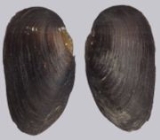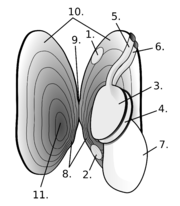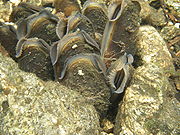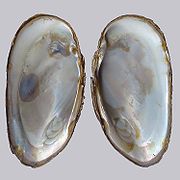
Freshwater pearl mussel
Encyclopedia
The freshwater pearl mussel, scientific name Margaritifera margaritifera, is an endangered species
of freshwater mussel
, an aquatic
bivalve mollusc in the family Margaritiferidae
.
The name "freshwater pearl mussel" should not be construed to mean that other freshwater mussels do not harbor pearls or cannot be used as mother of pearl. In fact, most cultured pearls today come from Hyriopsis species in Asia, or Amblema species in North America, both members of the related family Unionidae
; pearls are also found in genus unio
. The interior of the shell of this species has thick nacre
. It is capable of making fine quality pearl
s and was historically exploited in the search for pearl
s from wild sources. In recent times, the Russian malacologist Valeriy Zyuganov
received worldwide reputation after he discovered that the Pearl Mussel exhibited negligible senescence
and he determined that it had a maximum lifespan of 210–250 years. The data of V.V. Zyuganov have been confirmed by the Finnish malacologists and gained general acceptance.
 One of the longest-living invertebrates in existence, the freshwater pearl mussel has, like all bivalve molluscs, a shell consisting of two parts that are hinged together, which can be closed to protect the animal’s soft body within. The shell is large, heavy and elongated, typically yellowish-brown in colour when young and becoming darker with age. Older parts of the shell often appear corroded, an identifying feature of this mussel species. The inner surface of the shell is pearl white, sometimes tinged with attractive iridescent colours. Like all molluscs, the freshwater pearl mussel has a muscular 'foot'; this very large, white foot enables the mussel to move slowly and bury itself within the bottom substrate of its freshwater habitat.
One of the longest-living invertebrates in existence, the freshwater pearl mussel has, like all bivalve molluscs, a shell consisting of two parts that are hinged together, which can be closed to protect the animal’s soft body within. The shell is large, heavy and elongated, typically yellowish-brown in colour when young and becoming darker with age. Older parts of the shell often appear corroded, an identifying feature of this mussel species. The inner surface of the shell is pearl white, sometimes tinged with attractive iridescent colours. Like all molluscs, the freshwater pearl mussel has a muscular 'foot'; this very large, white foot enables the mussel to move slowly and bury itself within the bottom substrate of its freshwater habitat.
 The native distribution of this species is Holarctic
The native distribution of this species is Holarctic
. The freshwater pearl mussel can be found on both sides of the Atlantic, from the Arctic and temperate regions of western Russia, through Europe to north-eastern North America.
Attached to the gills of a fish, the glochidia live and grow in this oxygen-rich environment until the following May or June, when they drop off. The juvenile must land on clean gravely or sandy substrates if it is to successfully grow. Attached to the substrate, juvenile freshwater pearl mussels typically burrow themselves completely into the sand or gravel, while adults are generally found with a third of their shell exposed. Should they become dislodged, freshwater pearl mussels can rebury themselves, and are also capable of moving slowly across sandy sediments, using their large, muscular foot.
The freshwater pearl mussel grows extremely slowly, inhaling water through exposed siphons, and filtering out tiny organic particles on which it feeds. It is thought that in areas where this species was once abundant, this filter feeding acted to clarify the water, benefiting other species which inhabited the rivers and streams. Maturity is reached at an age of 10 to 15 years, followed by a reproductive period of over 75 years in which about 200 million larvae can be produced. In early summer each year, around June and July, male freshwater pearl mussels release sperm into the water, where they are inhaled by female mussels. Inside the female, the fertilised eggs develop in a pouch on the gills for several weeks, until temperature or other environmental cue triggers the female to release the larvae into the surrounding water.

(Dreissena polymorpha), which has been spread to new locations by being transported on the bottom of boats or in ballast waters, has impacted freshwater pearl mussel populations in all countries it has invaded.
The freshwater pearl mussel, which is completely protected in most European countries, has been the focus of a significant amount of conservation efforts. Measures have included the transfer of adult mussels to areas where it had gone extinct, the culture of juvenile mussels, and the release of juvenile trout, which have been infected with glochidia, into small rivers, but mainly the freshwater pearl mussel has benefited from habitat restoration projects in some areas. Due to the essential role salmonid fish play in the life of the freshwater pearl mussel, the conservation of salmon and trout is also central in the survival of this endangered freshwater mussel.
Endangered species
An endangered species is a population of organisms which is at risk of becoming extinct because it is either few in numbers, or threatened by changing environmental or predation parameters...
of freshwater mussel
Mussel
The common name mussel is used for members of several families of clams or bivalvia mollusca, from saltwater and freshwater habitats. These groups have in common a shell whose outline is elongated and asymmetrical compared with other edible clams, which are often more or less rounded or oval.The...
, an aquatic
Aquatic animal
An aquatic animal is an animal, either vertebrate or invertebrate, which lives in water for most or all of its life. It may breathe air or extract its oxygen from that dissolved in water through specialised organs called gills, or directly through its skin. Natural environments and the animals that...
bivalve mollusc in the family Margaritiferidae
Margaritiferidae
Margaritiferidae is a family of medium-sized freshwater mussels, aquatic bivalve mollusks in the order Unionoida. They are known as freshwater pearl mussels, because they are capable of producing pearls.-Genera within the family Margaritiferidae:...
.
The name "freshwater pearl mussel" should not be construed to mean that other freshwater mussels do not harbor pearls or cannot be used as mother of pearl. In fact, most cultured pearls today come from Hyriopsis species in Asia, or Amblema species in North America, both members of the related family Unionidae
Unionidae
Unionidae is a family of freshwater mussels, the largest in the order Unionoida, the bivalve mollusks sometimes known as river mussels, naiads, or simply as unionids.The range of distribution for this family is world-wide...
; pearls are also found in genus unio
Unio (genus)
Unio is a genus of medium-sized freshwater mussels, aquatic bivalve mollusks in the family Unionidae, the river mussels.Unio is the type genus of the family Unionidae.-Species:Species in the genus Unio include:* Unio cariei - extinct...
. The interior of the shell of this species has thick nacre
Nacre
Nacre , also known as mother of pearl, is an organic-inorganic composite material produced by some mollusks as an inner shell layer; it is also what makes up pearls. It is very strong, resilient, and iridescent....
. It is capable of making fine quality pearl
Pearl
A pearl is a hard object produced within the soft tissue of a living shelled mollusk. Just like the shell of a mollusk, a pearl is made up of calcium carbonate in minute crystalline form, which has been deposited in concentric layers. The ideal pearl is perfectly round and smooth, but many other...
s and was historically exploited in the search for pearl
Pearl
A pearl is a hard object produced within the soft tissue of a living shelled mollusk. Just like the shell of a mollusk, a pearl is made up of calcium carbonate in minute crystalline form, which has been deposited in concentric layers. The ideal pearl is perfectly round and smooth, but many other...
s from wild sources. In recent times, the Russian malacologist Valeriy Zyuganov
Valeriy Zyuganov
Valeriy Valeryevich Zyuganov is a Soviet and Russian biologist, and Doctor of Biological Sciences. He is the pupil and follower of professors V.V. Khlebovich, and Yu. A...
received worldwide reputation after he discovered that the Pearl Mussel exhibited negligible senescence
Negligible senescence
Negligible senescence refers to the failure of a few select animals to display symptoms of aging. More specifically, negligibly senescent animals do not have measurable reductions in their reproductive capability with age, or measurable functional decline with age. Death rates in negligibly...
and he determined that it had a maximum lifespan of 210–250 years. The data of V.V. Zyuganov have been confirmed by the Finnish malacologists and gained general acceptance.
Subspecies
Subspecies within the species Margaritifera magaritifera include:- Margaritifera margaritifera margaritifera (Linnaeus, 1758)
- Margaritifera margaritifera parvula (Haas, 1908)
- Margaritifera margaritifera durrovensis Phillips, 1928 - critically endangered subspecies in Ireland. Synonym: Margaritifera durrovensis. This subspecies is mentioned in annexes II and V of Habitats Directive as Margaritifera durrovensis.
Physical description

Distribution

Holarctic
The Holarctic ecozone refers to the habitats found throughout the northern continents of the world as a whole. This region is divided into the Palearctic, consisting of Northern Africa and all of Eurasia, with the exception of Southeast Asia and the Indian subcontinent, and the Nearctic,...
. The freshwater pearl mussel can be found on both sides of the Atlantic, from the Arctic and temperate regions of western Russia, through Europe to north-eastern North America.
- More than half the world's recruiting population exists in Scotland with populations in more than 50 rivers, mainly in the HighlandsScottish HighlandsThe Highlands is an historic region of Scotland. The area is sometimes referred to as the "Scottish Highlands". It was culturally distinguishable from the Lowlands from the later Middle Ages into the modern period, when Lowland Scots replaced Scottish Gaelic throughout most of the Lowlands...
, although illegal harvesting has seriously affected their survival. 75% of sites surveyed in 2010 had suffered "significant and lasting criminal damage" and in response the police and Scottish Natural HeritageScottish Natural HeritageScottish Natural Heritage is a Scottish public body. It is responsible for Scotland's natural heritage, especially its natural, genetic and scenic diversity. It advises the Scottish Government and acts as a government agent in the delivery of conservation designations, i.e...
have launched a campaign to protect the species. - North America: eastern Canada and New EnglandNew EnglandNew England is a region in the northeastern corner of the United States consisting of the six states of Maine, New Hampshire, Vermont, Massachusetts, Rhode Island, and Connecticut...
at northwestern of the United States - Europe, including:
- Austria
- Belgium
- Czech Republic - critically endangeredCritically endangeredVersion 2010.3 of the IUCN Red List of Threatened Species identified 3744 Critically Endangered species, subspecies and varieties, stocks and subpopulations.Critically Endangered by kingdom:*1993 Animalia*2 Fungi*1745 Plantae*4 Protista-References:...
(CR). In Bohemia, probably locally extinct in Moravia. Listed in Decree for implementation, No. 395/1992 Sb. (Czech code) (in Czech: Vyhláška 395/1992 Sb. ve znění vyhl. 175/2006 Sb.) as Critically Threatened species. Its Conservation status in 2004-2006 is bad (U2) in report for European commissionEuropean CommissionThe European Commission is the executive body of the European Union. The body is responsible for proposing legislation, implementing decisions, upholding the Union's treaties and the general day-to-day running of the Union....
in accordance with Habitats Directive. - Denmark
- Estonia
- France
- Germany - critically endangered (vom Aussterben bedroht). Listed as strictly protected species in annex 1 in Bundesartenschutzverordnung.
- Great Britain. This species has been fully protected in the United Kingdom under the Wildlife and Countryside Act 1981Wildlife and Countryside Act 1981The Wildlife and Countryside Act 1981 is an Act of Parliament in the United Kingdom and was implemented to comply with the Directive 2009/147/EC on the conservation of wild birds...
since 1998 and partly protected according to section 9(1) since 1991. - Ireland. The Cladagh (Swanlinbar) riverRiver Cladagh (Swanlinbar)The Cladagh River or Swanlinbar River is a moderately large river which forms from a number of small streams rising on the south-eastern slopes of Cuilcagh Mountain, County Cavan and flows through the village of Swanlinbar, before crossing the border into County Fermanagh and eventually flowing...
contains one of the largest populations surviving in Northern IrelandNorthern IrelandNorthern Ireland is one of the four countries of the United Kingdom. Situated in the north-east of the island of Ireland, it shares a border with the Republic of Ireland to the south and west...
, estimated minimum 10,000, confined to a 6 km stretch of undisturbed river in the middle section. - Luxembourg
- Lithuania - extinct
-
- Poland - extinct
- Iberian Peninsula (Portugal and Spain)
- FennoscandiaFennoscandiaFennoscandia and Fenno-Scandinavia are geographic and geological terms used to describe the Scandinavian Peninsula, the Kola Peninsula, Karelia and Finland...
- vulnerable in Finland and Norway, endangered in Sweden . Very rare in southern Finland, more common in the north. Widespread but not common in Norway; Norway is considered to host a large proportion of the European stock. Rare in Sweden . Also in Kola Peninsula and Karelia (Russia) (see below). - Russian Federation - in the rivers of the White SeaWhite SeaThe White Sea is a southern inlet of the Barents Sea located on the northwest coast of Russia. It is surrounded by Karelia to the west, the Kola Peninsula to the north, and the Kanin Peninsula to the northeast. The whole of the White Sea is under Russian sovereignty and considered to be part of...
basin of the ArkhangelskArkhangelsk OblastArkhangelsk Oblast is a federal subject of Russia . It includes the Arctic archipelagos of Franz Josef Land and Novaya Zemlya, as well as the Solovetsky Islands in the White Sea....
and MurmanskMurmansk OblastMurmansk Oblast is a federal subject of Russia , located in the northwestern part of Russia. Its administrative center is the city of Murmansk.-Geography:...
Regions. It is east border of the area of distribution M. margaritifera.
Habitat
Clean, fast-flowing streams and rivers are required for the freshwater pearl mussel, where it lives buried or partly buried in fine gravel and coarse sand, generally in water at depths between 0.5 and 2 metres, but sometimes at greater depths. Clean gravel and sand is essential, particularly for juvenile freshwater pearl mussels, for if the stream or river bottom becomes clogged with silt, they cannot obtain oxygen and will die. Also essential is the presence of a healthy population of salmonids, a group of fish including salmon and trout, on which the freshwater pearl mussel relies for part of its life cycle.Lifecycle
Capable of living for over an incredible 200 years, the freshwater pearl mussel begins life as a tiny larva, measuring just 0.6 to 0.7 millimetres long, which is ejected into the water from an adult mussel in a mass of one to four million other larvae. This remarkable event takes place over just one to two days, sometime between July and September. The larvae, known as glochidia, resemble tiny mussels, but their minute shells are held open until they snap shut on a suitable host. The host of freshwater pearl mussel larvae are juvenile fish from the salmonid family, which includes the Atlantic salmon and sea trout. The chances of a larva encountering a suitable fish is very low, and thus nearly all are swept away and die; only a few are inhaled by an Atlantic salmon or sea trout, where they snap shut onto the fish’s gills.Attached to the gills of a fish, the glochidia live and grow in this oxygen-rich environment until the following May or June, when they drop off. The juvenile must land on clean gravely or sandy substrates if it is to successfully grow. Attached to the substrate, juvenile freshwater pearl mussels typically burrow themselves completely into the sand or gravel, while adults are generally found with a third of their shell exposed. Should they become dislodged, freshwater pearl mussels can rebury themselves, and are also capable of moving slowly across sandy sediments, using their large, muscular foot.
The freshwater pearl mussel grows extremely slowly, inhaling water through exposed siphons, and filtering out tiny organic particles on which it feeds. It is thought that in areas where this species was once abundant, this filter feeding acted to clarify the water, benefiting other species which inhabited the rivers and streams. Maturity is reached at an age of 10 to 15 years, followed by a reproductive period of over 75 years in which about 200 million larvae can be produced. In early summer each year, around June and July, male freshwater pearl mussels release sperm into the water, where they are inhaled by female mussels. Inside the female, the fertilised eggs develop in a pouch on the gills for several weeks, until temperature or other environmental cue triggers the female to release the larvae into the surrounding water.

Threats and conservation
Once the most abundant bivalve mollusc in ancient rivers around the world, numbers of the freshwater pearl mussel are now declining in all countries and this species is nearly extinct in many areas. The causes of this decline are not fully understood, but alteration and degradation of its freshwater habitat undoubtedly plays a central role. The negative impacts humans have on rivers and streams come from a wide range of activities such as river regulation, drainage, sewage disposal, dredging, and water pollution, including the introduction of excess nutrients. Anything that affects the abundance of the fish hosts will also affect the freshwater pearl mussel; for example, the introduction of exotic fish species, such as the rainbow trout, reduces the number of native fish hosts. Introduced species are also directly affecting the freshwater pearl mussel; the invasion of the zebra musselZebra mussel
The zebra mussel, Dreissena polymorpha, is a small freshwater mussel. This species was originally native to the lakes of southeast Russia being first described in 1769 by a German zoologist Peter Simon Pallas in the Ural, Volga and Dnieper rivers. They are still found nearby, as Pontic and Caspian...
(Dreissena polymorpha), which has been spread to new locations by being transported on the bottom of boats or in ballast waters, has impacted freshwater pearl mussel populations in all countries it has invaded.
The freshwater pearl mussel, which is completely protected in most European countries, has been the focus of a significant amount of conservation efforts. Measures have included the transfer of adult mussels to areas where it had gone extinct, the culture of juvenile mussels, and the release of juvenile trout, which have been infected with glochidia, into small rivers, but mainly the freshwater pearl mussel has benefited from habitat restoration projects in some areas. Due to the essential role salmonid fish play in the life of the freshwater pearl mussel, the conservation of salmon and trout is also central in the survival of this endangered freshwater mussel.
Further reading
- Anonymous 2004. Margaritifera margaritifera. Stage 1 and Stage 2 survey guidelines. Irish Wildlife Manuals, No. 12. National Parks and Wildlife Service, Department of Environment, Heritage and Local Government, Dublin, Ireland. 25 pp.
- Moorkens E. A. 2000. Conservation Management of the Freshwater Pearl Mussel Margaritifera margaritifera. Part 2: Water Quality Requirements. Irish Wildlife Manuals, No. 9., 44 pp.

